Radios¶
Warning
The internal radio of Veronte Autopilots 1x depends on the hardware version, so the user should check the internal radio according to the hardware version of his 1x Autopilot:
Digi internal radio¶
Configuration¶
This section describes the necessary configuration for 1x PDI Builder and the Digi radio software (XCTU) to allow a correct communication between Veronte Autopilot 1x and its internal Digi radio.
To configure the communication between autopilots 1x and their internal Digi radios, apply the following steps to each one (air and BCS/PCS unit):
Connect the Autopilot 1x to a computer with Veronte Link, read the user manual to use it.
Configuration in 1x PDI Builder
Go to Input/Output menu \(\rightarrow\) I/O Setup section.
Since the configuration of this menu is going to be modified temporarily, i.e. the current configuration will have to be re-established, just to be able to set up a tunnel between the autopilot and the radio.
It is necessary that the user first annotates the configuration of USB, Veronte LOS and the ports to which they are connected. The following image shows an example.
Note
It is recommended to take a screenshot for this step.
Warning
Although the connection with 1x Autopilot will be lost via USB, users can still “see” the autopilot via serial (RS232 or RS485). For this purpose, the bidirectional RS232 or RS485 connection must not be modified.
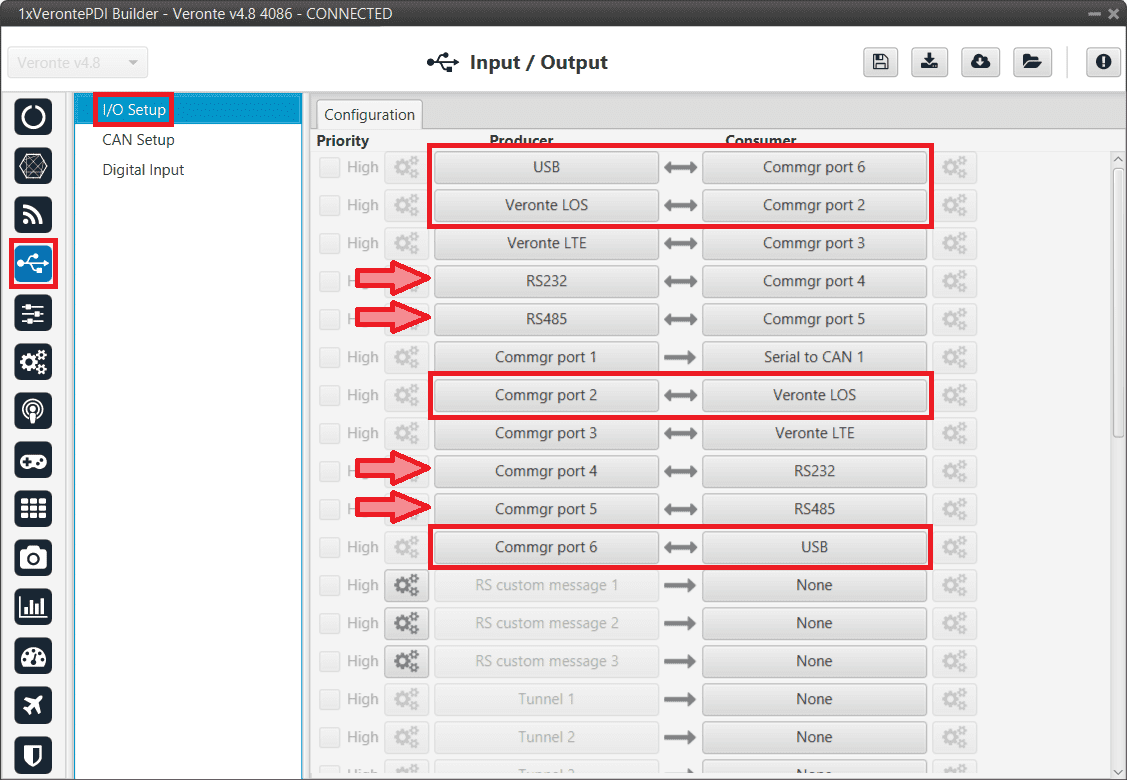
Example of configuration of USB and Veronte LOS ports¶
Change the port which USB producer is connected to and select Veronte LOS as consumer.
USB and Veronte LOS must have bidirectional communication \(\longleftrightarrow\).
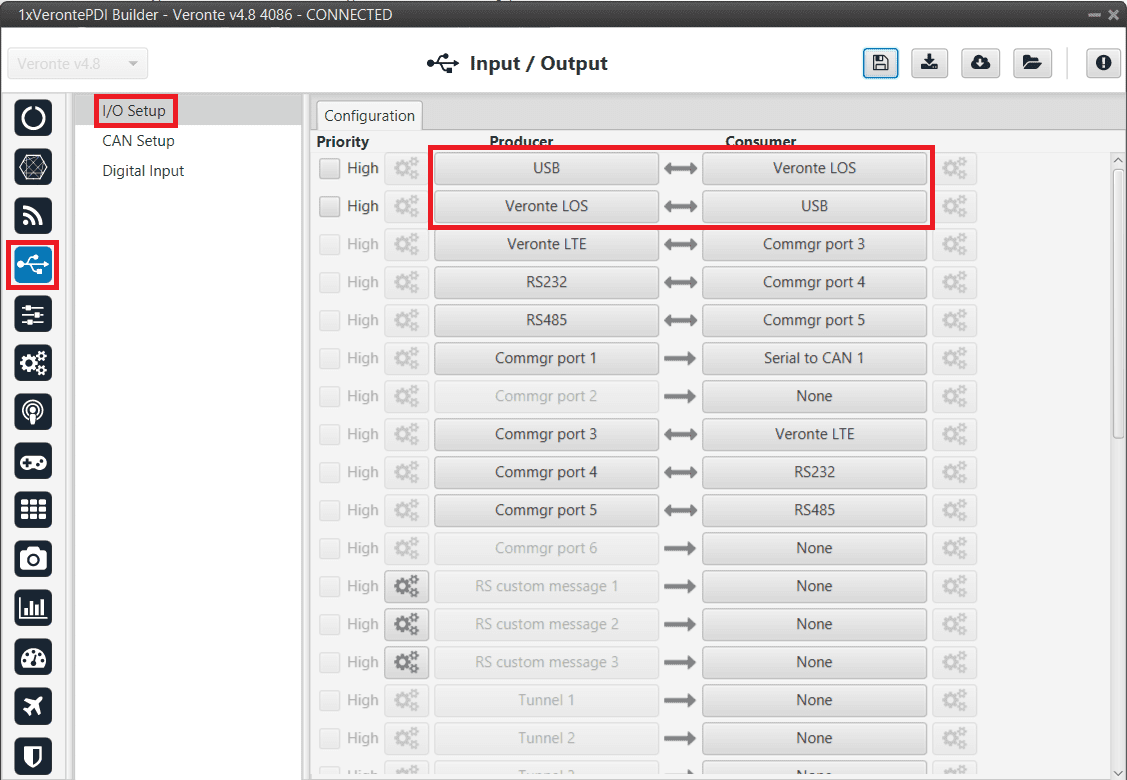
USB \(\longleftrightarrow\) Veronte LOS¶
Go to Communications menu \(\rightarrow\) Veronte LOS section.
It is important to know which baudrate is configured for the Veronte LOS serial port in order to match it with the one configured in the Digi radio.
By default, the baudrate configured in 1x PDI Builder is set to 115200.
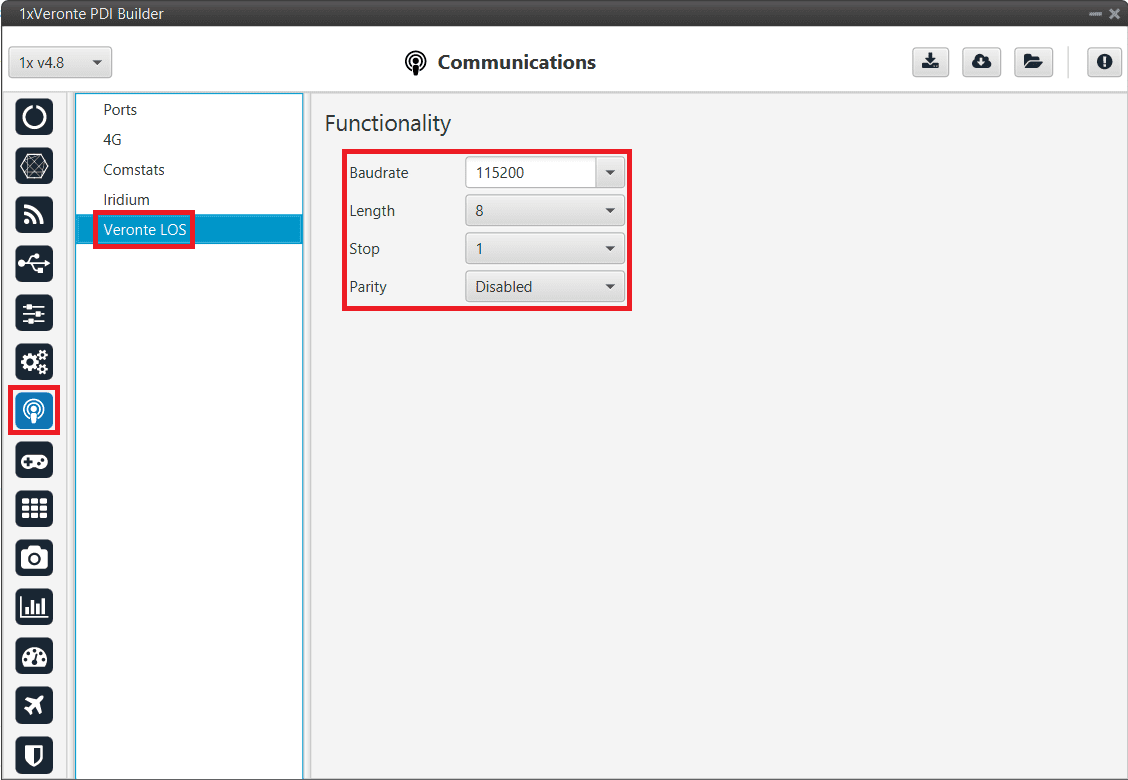
Veronte LOS baudrate¶
Warning
The communication between computer and Autopilot 1x will be disconnected, since the autopilot is working as a tunnel between computer and radio. The computer will be communicating only with the Digi radio.
Wait for the device to disconnect and close Veronte Link. If the user does not close it, XCTU software will not be able to detect the radio as the COM is being managed by Veronte Link, and the following error message will appear:

XCTU error message¶
Important
Remember that to completely close the application the user must close it from the windows system tray.

Close Veronte Link¶
Configuration in Digi radio software
Download and install XCTU (Digi radio software).
Build a configuration for ‘air’ or ‘bcs’ in XCTU:
The integrated radio is the model DIGI-XBEE3 XB3-24Z8UM. For more information about how to configure it, read the XCTU User Guide.
The following table shows which parameters can be configured. The rest of parameters should remain as default.
DIGI Parameter
Description
PL
Transmit power (100 mW)
ID
Network addres PAN ID
DD
Device type identifier
BD
UART baud rate (115200)
RR
Retries (minimum 5)
CH
2.4 GHz channel to send
MM
Mac mode, 802.15.4 with Digi header for discovery and packages duplicate
CA
Clear channel threshold as dBm
EA
Ack failures
EC
Failure to sent due to excess of energy in channel
Note
Radios to pair must have matching PAN IDs.
Warning
Check that the baudrate of the radio matches the baudrate configured in 1x PDI Builder. If it is not the same, change one of them to match. Remember that Veronte LOS baudrate must not exceed 115200, as this may compromise proper communication.
Only for Autopilots 1x implemented in a 4x
Digi radios are able to create a network and talk to each other, even if they are configured as endpoint.
This is a problem, as it leads to radio channel overload. To prevent this problem, the destination addresses must be configured so that the ground station transmits in broadcast and each air unit transmits only to the ground.
The following table shows how to configure air and ground units in XCTU:
Radio
Parameter
Configuration
Ground
MY 16-bit Source Address
FFFFDH Destination Address High
0DL Destination Address Low
FFFFAir
MY 16-bit Source Address
FFFFDH Destination Address High
SH of the ground radio
DL Destination Address Low
SL of the ground radio

Air configuration example¶

Ground configuration example¶
After configuring the radio, the communication between computer and Autopilot 1x should be restored. To do it, force the maintenance mode.
Configuration in 1x PDI Builder
Go to Input/Output menu \(\rightarrow\) I/O Setup section.
Finally, after configuring the Digi radio in its software, restore the annotated USB and Veronte LOS configuration (step 2).
If after the whole process described above for setting up the radio or later during operation the communication between the Digi radio and the Veronte Autopilot 1x is lost, please check the Communication lost with intenal Digi radio - > Troubleshooting section of this manual.
Operational range¶
The following table is a reference of the functional range for each telemetry load (it may be affected by enviromental conditions):
Frequency |
|||
|---|---|---|---|
Load |
5 Hz |
10 Hz |
20 Hz |
Low (Half telemetry vector) |
> 700 m |
500 m |
300 m |
Medium (one telemetry vector) |
> 700 m |
100 m |
80 m |
High (two or more telemetry vectors) |
300 m |
80 m |
X |
Note
Telemetry vectors are structured messages with up to 255 bytes of data. To know more about them, read VCP manual -> Message structure.
Microhard internal radio¶
This section describes the necessary configuration that must be performed in 1x PDI Builder and 1x PDI Calibration to allow a correct communication between Veronte Autopilot 1x and its internal Microhard radio.
To configure the communication between autopilots 1x and their internal Microhard radios, apply the following steps to each one (air and bcs unit):
Connect the Autopilot 1x to a computer with Veronte Link, read the user manual to use it.
Configuration in 1x PDI Builder
Go to Input/Output menu \(\rightarrow\) I/O Setup section.
Since the configuration of this menu is going to be modified temporarily, i.e. the current configuration will have to be re-established, just to be able to set up a tunnel between the autopilot and the radio.
It is necessary that the user first annotates the configuration of Veronte LOS, Tunnel and the ports to which they are connected. The following image shows an example.
Note
It is recommended to take a screenshot for this step.

Example of configuration of Veronte LOS port¶
Change the port which Veronte LOS producer is connected to and select a Tunnel as consumer, in this example Tunnel 1 has been selected.
Veronte LOS and Tunnel 1 must have bidirectional communication \(\longleftrightarrow\).
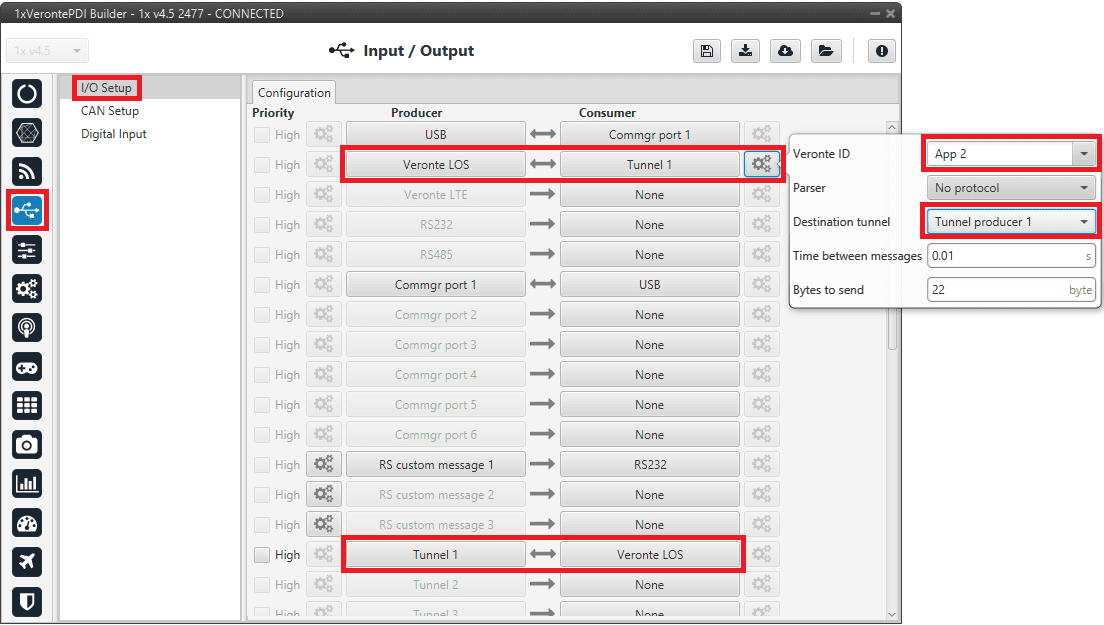
Veronte LOS \(\longleftrightarrow\) Tunnel 1¶
Configuration in 1x PDI Calibration
In 1x PDI Calibration, go to Terminal menu.
To set up the Microhard radio, the 1x PDI Calibration software provides a Microhard wizard to assist the user in setting up the radio.
Please refer to the Terminal and Microhard setup helper sections of the 1x PDI Calibration user manual.
Configuration in 1x PDI Builder
External radios¶
This section describes the required configuration to be performed in 1x PDI Builder to allow a correct connection between Veronte Autopilot 1x and any external radio.
External radios compatible with the autopilot 1x, such as Microhard, DTC, Digi, Silvus and Veronte Data Link (Embention external radio, contact sales@embention.com for more information).
After configuring the external radio in the corresponding software, follow the steps below:
Go to Connections menu \(\rightarrow\) Serial section \(\rightarrow\) 232 tab.
Check that these parameters are the same as the parameter values previously set in the external radio.
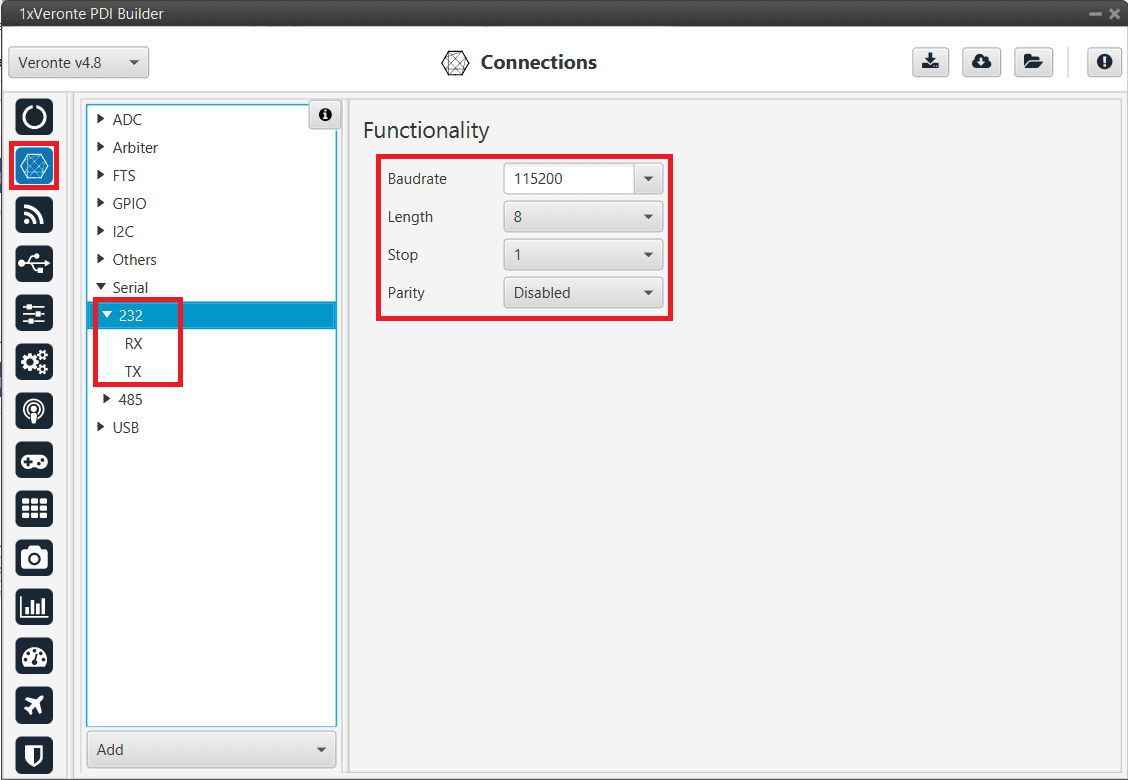
RS-232 connection configuration¶
Go to Input/Output menu \(\rightarrow\) I/O Setup section.
RS-232 has to be configured as a bidirectional commgr port.
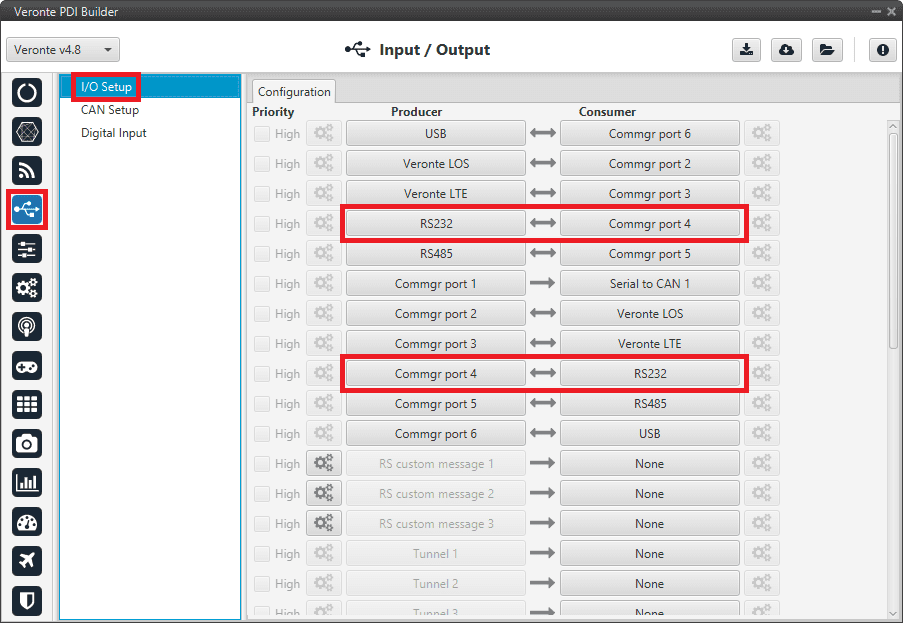
RS-232 I/O configuration¶
Note
These settings have to be made in both 1x autopilot units (GND and AIR).
